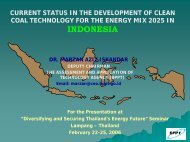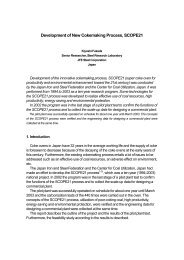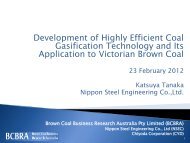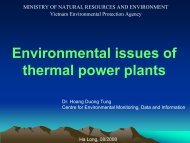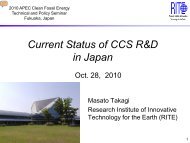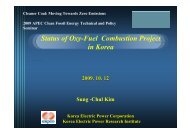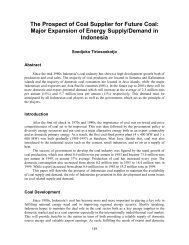Defining CCS Ready: An Approach to An International Definition
Defining CCS Ready: An Approach to An International Definition
Defining CCS Ready: An Approach to An International Definition
- No tags were found...
Create successful ePaper yourself
Turn your PDF publications into a flip-book with our unique Google optimized e-Paper software.
Chapter 4: S<strong>to</strong>rage <strong>Ready</strong> Plant <strong>Definition</strong>assessment would focus on the most viable opportunities, and importantly would need <strong>to</strong>co-develop multiple sites in case one area is found not <strong>to</strong> be adequate or has levels ofuncertainty that are <strong>to</strong>o high or cannot be easily resolved.Categories of Capacity EstimatesMost (>95%) of the values in the published literature are theoretical estimates, 98 and thusare of no practical value for planning purposes <strong>to</strong> develop S<strong>to</strong>rage <strong>Ready</strong> plants. Even thedocumented s<strong>to</strong>rage capacity volume in Chapter 5 (Geological S<strong>to</strong>rage) of the IPCC’sSpecial Report on <strong>CCS</strong> 95 are not representative of the true extent of practical s<strong>to</strong>ragecapacity; 96 these values probably overstate the likely practical s<strong>to</strong>rage capacity andunderstate the economic reality of achieving the quoted s<strong>to</strong>rage capacity volumes. Thevalues quoted do not describe the highly theoretical nature of the s<strong>to</strong>rage capacitycalculations, which are at the physical limit of the rock pore volume <strong>to</strong> accept CO 2 (seebelow regarding pressure build-up).Bradshaw et al. raised the problems with the disparate data set of local and worldwideestimates for s<strong>to</strong>rage capacity, and the inadequate understanding of s<strong>to</strong>rage efficiency. 97 In apresentation of those findings in Oc<strong>to</strong>ber 2002 in Kyo<strong>to</strong>, Japan, the concept of a resourcepyramid was presented as a way <strong>to</strong> encapsulate the vagaries of CO 2 geological s<strong>to</strong>ragecapacity estimates. Subsequently, Bradshaw et al. 98 introduced the concept of quotings<strong>to</strong>rage capacity in terms of “theoretical,” “realistic,” and “viable” with a resource pyramid,which was later modified by Bachu et al. as “theoretical,” “effective,” “practical,” and“matched.” 99 (See Exhibit 4-2.) The UK CCR Guidance note uses the terms in the earlierBradshaw et al. paper, and recommends that the capacity estimates be in the category of“realistic” or “viable”—which could require significant effort in terms of exploration.The qualifying terms in Exhibit 4-2 need <strong>to</strong> be quoted alongside any numerical capacityestimate so it is clear whether the values are theoretical estimates or have some degree ofscience, modelling, and realistic validation and quantification behind them. To reach S<strong>to</strong>rage<strong>Ready</strong>, the estimates will have <strong>to</strong> progress up the resource pyramid definitions, withincreasing certainty from technical, commercial, legal, and regula<strong>to</strong>ry perspectives. Thus,conceptually in this scheme, as more information is used in an assessment, the smaller andmore certain the resource value estimate becomes. However, new information andexploration data will affect the prospectivity assessment and can alter the absolute capacityvalues as better knowledge and more data are produced. Normally, as each phase in thework plan is reached (Exhibit 4-1), a more refined capacity estimation can be produced, thusstepping through the s<strong>to</strong>rage capacity levels shown in Exhibit 4-2.95 Intergovernmental Panel on Climate Change (IPCC). (2005a). IPCC Special Report on Carbon Dioxide Capture andS<strong>to</strong>rage. New York, NY: Cambridge University Press.96 Holloway, S.. (2008). Advances in global and regional capacity assessment. Paper presented in Session 1A of GHGT-9:9 th international conference on greenhouse gas control technologies, Washing<strong>to</strong>n, DC.97 Bradshaw, J. et al.. (2003). Australia’s CO2 geological s<strong>to</strong>rage potential and matching of emission sources <strong>to</strong> potentialsinks. Energy, 29, 1623-1631. doi:10.1016/j.energy.2004.03.064.98 Figure 2 in Bradshaw, J., et al.. (2007). CO2 S<strong>to</strong>rage Capacity Estimation: Issues and development of standards.<strong>International</strong> Journal Greenhouse Gas Control 1,1, 62-68. doi:10.1016/S1750-5836(07)00027-8.99 Bachu, S., et al. (2007).CO2 s<strong>to</strong>rage capacity estimation: Methodology and gaps. <strong>International</strong> Journal of GreenhouseGas Control, 1, 4, 430-433. doi:10.1016/S1750-5836(07)00086-2.23 February 2010 54



